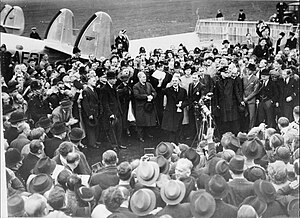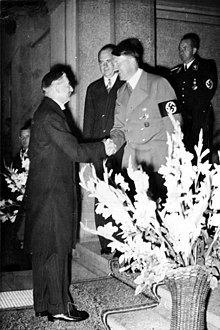Appeasement policy
Appeasement policy (from the English term: appeasement policy) is the name of a policy defined by the realization of political, economic and/or territorial concessions in the face of a aggressor power in order to avoid further conflict. The term has historically been associated with the foreign policy carried out by Neville Chamberlain as Prime Minister of the United Kingdom against Adolf Hitler's Germany, although it is applied in general terms to British and French foreign policy with respect to both Nazi Germany. such as Benito Mussolini's Italy during the 1920s and 1930s.
Shocked by the horrors of the First World War, as the most brutal conflict known until 1914, not a few European politicians wanted to maintain peace with the Germany of the Third Reich, regardless of the requests made by the aggressive Nazi regime, which meant allowing Hitler's constant violations of the different international treaties, as happened with the militarization of the Rhineland, a western German region where the Treaty of Versailles in 1919 had prohibited Germany from establishing military forces, arsenals or fortifications. When the Führer sent Wehrmacht troops to station themselves in the Rhineland in March 1936, the United Kingdom refused to protest this breach of the Versailles Treaty. Without British support, France also accepts without complaint this violation of said treaty.
The appeasement policy prevented, in the same year of 1936, Great Britain and France from imposing sanctions on Germany and Italy for their military intervention in the Spanish civil war, contrary to the agreements made between these countries not to provide war support to the Spanish factions in conflict. Nor did they sanction the Soviet Union for supporting the Republican side in the Civil War.
A similar situation was experienced with the issue of German rearmament carried out by the Third Reich since 1933, despite the fact that the Treaty of Versailles established maximum troop limits for the Reichswehr (the German army of the Weimar Republic) and It greatly reduced the range of the German navy and military aviation. Neither France nor Great Britain protested against such an infraction, which allowed Hitler to organize a much more powerful armed forces, the Wehrmacht.
In the case of the annexation of Austria to Germany (Anschluss) in March 1938, Great Britain and France also did not protest Hitler's violent pressures and threats to the Austrian government of Kurt Schuschnigg and allowed annexation despite the fact that the Treaty of Versailles had also expressly prohibited such an Austro-German political union.
The culminating moment of this policy was the Munich Conference of 1938, in which Chamberlain accepted the guarantees offered by Hitler to maintain the European balance, while sacrificing Czechoslovakia to German ambitions. However, on that occasion Neville Chamberlain seriously considered that he had avoided, and not just postponed, an armed conflict with Nazi Germany. In fact, after concluding the Munich Accords, he flew back to Great Britain and upon getting off the ship, Chamberlain issued a famous statement to the press gathered at the airfield, stating that the Munich Accords were "peace for our times" (" peace for our time»), which won him applause from the British public who really believed he had prevented a war.
The subsequent invasion of Poland in 1939, less than a year after the Munich Agreement, ultimately brought appeasement into disrepute, leading to Chamberlain's defeat in a vote of no confidence in the House of the Commons in May 1940, in front of Winston Churchill, who had been very harsh in his criticism of Chamberlain after his agreements with Hitler, despite the fact that both were members of the Conservative Party:
You had to choose between humiliation and war, chose humiliation and will lead us to war.Winston Churchill.
Many leaders in Great Britain and France considered the Soviet Union, ruled by Joseph Stalin, to be a more formidable and fearsome enemy than Nazi Germany; They were also confident that, having such conflicting ideologies and greater geographical proximity, Nazi ambitions would be directed only towards a threatening Soviet Union and not towards Western Europe, a calculation that turned out to be wrong. The appeasement policy allowed the following attacks by the nascent Axis:
- Invasion of Ethiopia in October 1935 by the Kingdom of Italy.
- Remilitarization of the Renania in March 1936 by Germany.
- Support of Fascist Italy and Nazi Germany to the subservient side in the Spanish civil war.
- An annexation of Austria by referendum in March 1938 by Germany.
- Occupation of the Sudetes in October 1938 by Germany.
- Occupation of the rest of the Czech Republic on March 15, 1939 by Germany.
- German ultimatum to Lithuania of 1939 and occupation of the Memel Territory.
- Albanian occupation in April 1939 by the Kingdom of Italy.
To date, the term "appeasement policy" is used with respect to conduct whereby a State accepts the conditions of a potential aggressor instead of offering resistance, in order to avoid an armed confrontation that may be costly and undesirable for both sides in conflict; it is considered that usually the "appeasing" State sacrifices its own principles to achieve this goal.
More recently, it has been used in reference to similar foreign policies towards Vladimir Putin's Russia, especially after the 2022 Invasion of Ukraine.
Contenido relacionado
Statue of Liberty
Inca empire
Chrysler Building

